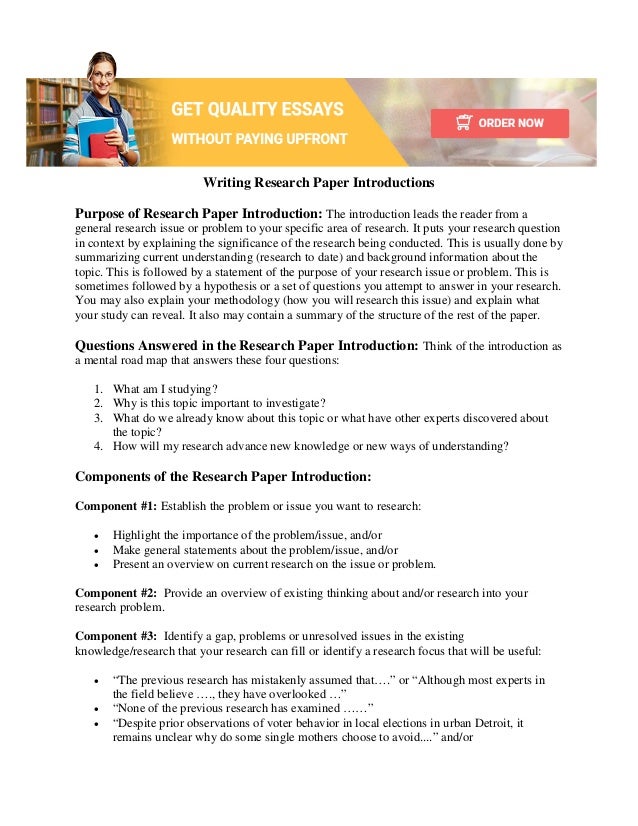When writing an introduction to a research paper, the reader should know what to expect from it. The first paragraph should briefly outline the scope of the study and the methodology involved. Highlight the main results and give a sneak preview of what the paper contains. Then, provide a brief conclusion or summary of the main findings. In addition, the introduction should be brief, but interesting and compelling. Here are some tips for writing an effective introduction for a research paper:
Creating an effective and engaging introductory paragraph for a research paper
The first step in creating an engaging and effective introductory paragraph for a research paper is defining your topic. The introduction should provide background information on the topic and include your thesis statement. The thesis statement establishes the writer’s point of view and specific aspects of the issue that the paper addresses. Consider the questions below as you write the introductory paragraph of your research paper. Use the answers to these questions as a starting point for your introduction.
The introductory paragraph should include a hook and a thesis sentence. The thesis statement should guide the reader toward the main idea of the paper. It should also be relevant to the topic. For example, if your research paper is about climate change, discuss how it affects the temperature of rivers and glaciers. If you are writing about a topic such as climate change, include how you think it may affect communities, cities, and neighborhoods. Make sure to challenge yourself and consider what you will do if climate change does affect you.
Outlining the scope of the research project
In a research paper, the introduction is the first part of the paper. It should summarize the main points of the paper and state the scope of your research. The introduction should include the hypothesis, line of inquiry, and potential outcomes of the research project. The introduction should be written in such a way that it stands alone, even if a reader doesn’t read the rest of the paper.
A well-written introduction will present the subject of the paper and its purpose. It should describe the unique aspects of the work, give a hypothesis, and present the background and justification of the research. It should also preview the results of the research. The introduction should be targeted towards an audience of instructors and peers, so it should provide an overview of the major points of the paper.
Highlighting the main results in the introduction
The introduction of a research paper sets the stage for the entire work, from the background information to the specific questions the study seeks to answer. The length of the introduction depends on the journal and the amount of background information you want to include. In the methods section, include references to previous publications and use specialized statistical software when appropriate. Listed below are some examples of the types of information to include in an introduction.
The introduction must state or imply a research problem, which may not be a statement of the research problem itself. While many writers choose to place the hypothesis or the thesis statement in the introduction, it is not necessary. The introduction should serve as a brief roadmap to the remainder of the paper, indicating that the author has a clear understanding of the paper’s structural purpose. In this way, the introduction will serve as a promise to readers and to yourself.
Providing a preview of the main results in the introduction
The introduction is a key part of a research paper because it introduces your readers to your findings and guides them through the rest of your paper. The main goal of the introduction is to give the reader a preview of the main results of your study. The introduction should be a brief, clear statement that explains the purpose of the study, the data you collected, and the analysis you used to reach your conclusions.
The first paragraph of your introduction should summarize relevant background information and then state your hypothesis. Your purpose is to give your audience an idea of what to expect from the rest of the paper. A brief overview of relevant literature is essential for the introduction. Moreover, the introduction should end with a brief sentence that explains the experiment question. This way, your audience will be able to determine whether or not the paper will be useful or not.
Creating a strong thesis statement in the introduction
When constructing a thesis statement for a research paper, you want to be clear, specific, and to the point. It should be specific enough to eliminate any ambiguity and focus your paper’s content on a narrow topic. It also needs to be within the scope of the research you are conducting. Here are some tips for developing a strong thesis statement:
The thesis statement must be a clear, concise statement that answers the question or argument the reader will be trying to answer. It must also include a counterargument that challenges the thesis statement. For example, if you are writing about the impact of uniforms on student freedom, you might mention how they limit the freedom of students, which is a violation of basic human rights. The thesis statement should be short, but should be packed with valuable information. It must also be backed up by facts and logic.

